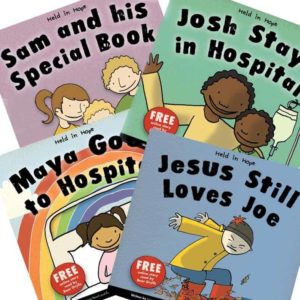Ten years ago I help make the best books I’ve ever made: the Held in Hope series.
At the time I was working for Christian Education, and Paul Nash contacted us to ask if we could work with them to produce a book for sick children. I went to visit him at Birmingham Childrens’ Hospital, where he heads up the (totally amazing) chaplaincy team. As part of our meeting, Paul gave me a tour of the hospital. I had never been in a childrens’ hospital before, and it wrecked me for about three days! I still remember seeing tiny people being wheeled along a corridor on big hospital beds, so many tubes and parents wandering the halls looking like this was a completely normal place to be.
When I had recovered, I started work with Paul and his team including members of the Pediatric Chaplaincy Network to make the book. It was clear after one meeting that we needed more than one book – in the first meeting the team came up with topics for about 30 books! I suggested we go for one age group and one topic per book, starting with four books. We chose the age range 2 – 7 years, as most children in children’s hospitals are under 2 years old (yes! that shocked me too!) and so their siblings of children are likely to be 2 – 7 years old. What we actually found was that the books we created work across all ages, including adults.
Working with with Paul Nash and the team, I learnt so much about caring for ill, dying and grieving children. They really are experts at this stuff, as they do it every day, working with families in children’s wards and in children’s hospitals around the country. Their grace and joy in the face of so much suffering was incredible to witness, as was their desire to offer the very best spiritual care possible. They not only work with children and their families, but also with the staff! Just after we published the books, they were filmed for a BBC documentary which was a fabulous window into their life.
We worked hard to make the books age-appropriate not just in terms of the words and the illustrations (by the talented Rhiannon Mollart), but also in terms of the topics we addressed and the theology we used. For example, young children will rarely ask why someone has died, but where they are now. For this reason, the book Sam’s Special Book focuses on Jesus going to prepare a place for us, and people’s ideas about what heaven is like. The theology is woven into each story in a way which children of that age ‘receive’ theology, for example Sam remembers a story he’s heard at Sunday school, while in other books Josh is taught a Christian song by a friend he meets, and Joe receives a letter from his Aunty Sue (named after my Mum, who has written many brilliant letters in her time).
Sickness, death, heaven and grief are not topics anyone wants to talk to young children about, but it’s safe to say that they are topics we will all encounter in our lives, sooner or later. The books tackle these difficult topics head-on but in a gentle way, using words such as ‘died’ rather than unclear phrases such as ‘gone away’ or ‘gone to sleep’, modelling good practice the chaplains know is helpful for young children. (If someone has disappeared and is said to have ‘gone to sleep’, a young child could worry that this might happen to them and therefore not want to go to sleep!)
I wrote the text of the books in consultation with the chaplains, and working closely with the illustrator. I wanted to only write what couldn’t be said in the pictures, as I believe a good picture book works like this. I’m a visual person, so I love to be able to tell the story using the pictures, which was actually something we did to test the story-telling-power of the pictures (my now teenage god-daughter, Kez, may not remember, but she was really helpful in reading the pictures to me!)
We also wanted to leaving space for families to have conversations about what they think and feel about the topics, so we intentionally left many details out. When Maya goes to hospital, we don’t know why she goes. Maybe it was a bee sting or perhaps she broke her leg. Sometimes it’s easier for a child to see themselves in the story if the story hasn’t got all the details. We were also aware that we wanted both girls and boys to read and be helped by the books, so we purposefully had both genders in each book. (I remember Rhiannon and I working together to get the names right!)
Even though I’m a big fan of books, we thought it would be amazing to have videos of each book being read, kind of Jackanory style. Rhiannon did an amazing job of making the pictures come alive, and we even managed to get Bear Grylls to read them for us. (I really hoped I’d get to meet him, but sadly he was filming on location in New Zealand at the time!) He does a great job with the stories, as you’ll see here. The videos are particularly good for sharing with parents who have lost someone they love, but also need to chat with their children about it while they themselves are grieving. I always recommend pre-watching them, not because they need vetting, but because they tend to make adults cry! There is such a lot of beautiful truth in them, especially in Rhiannon’s artwork. You will be glad you had tissues ready.
We launched the books at a conference held at Birmingham Childrens’ Hospital where we had a full day of training in pediatric spiritual care, which was amazing just to be at. As I’ve said, these guys really know their stuff and they’re forever trialing new things, reviewing it and training people from all over the country in this work.
I’ve always said that despite these being topics no parent really wants to have with their child, the best time to talk about sickness, death and grieving is when those topics aren’t pertinent. I recommend them to families who don’t (yet) need them, as they are the perfect way to start important conversations.
Shortly after the launch, my first daughter was born. Having said everyone should share these books with their children, would I really do this with mine? After all, we don’t know anyone who was ill or dying. I discovered that around the age of 3, my daughter and many of her peers started asking questions about death. It seems that it’s part of their development at that stage, and so I got out the books and we read them together. My 3 and 2 years old daughters responded to the books just as they did any other book in our collection, treating the stories just as if they were The Grufallo! Afterwards, I wondered if they’d even really understood what we’d read. “Never mind,” I thought. “There’s plenty of time to read them again.”
About six months later, having not read them again yet, they had a profound conversation at bath time. Out of the blue, my three year old said: “Mummy, there’s no pain in heaven, is there?” (This is something which is specifically mentioned in Jesus Still Loves Joe.) To which my 2 year old replied: “No, Jesus, he wipe away all the pain like wiping up milk.”
So what would I say ten years later?
The Held in Hope books are still the hardest and best books I’ve written. I remember the hours we spent discussing the name for the series, wanting it to express how the experience of the child during and after being read the stories. We spent time imaging what Jesus might say to a child who is dying or grieving, and we came to conclusion he probably wouldn’t say anything. He would just hold them. Held in hope – the title says it all.
If you’ve not got a set yet, you can get yours here.


